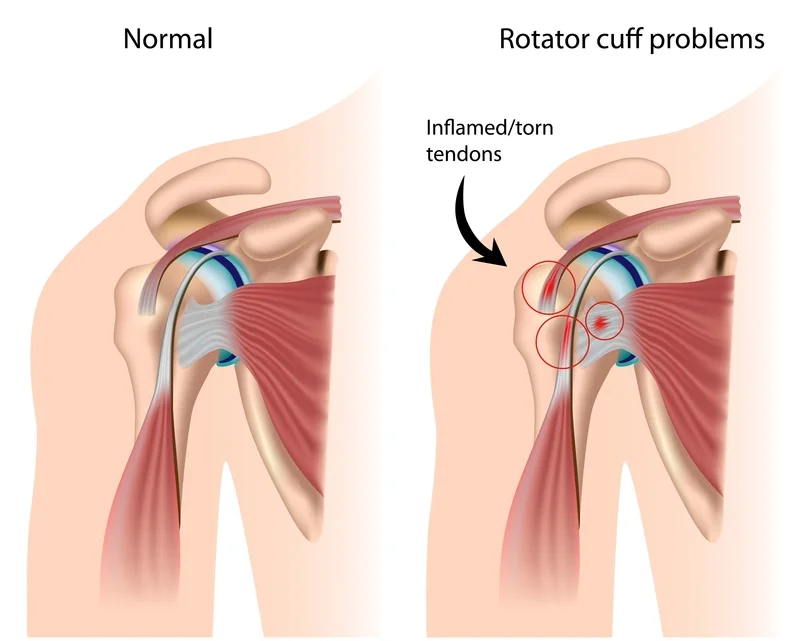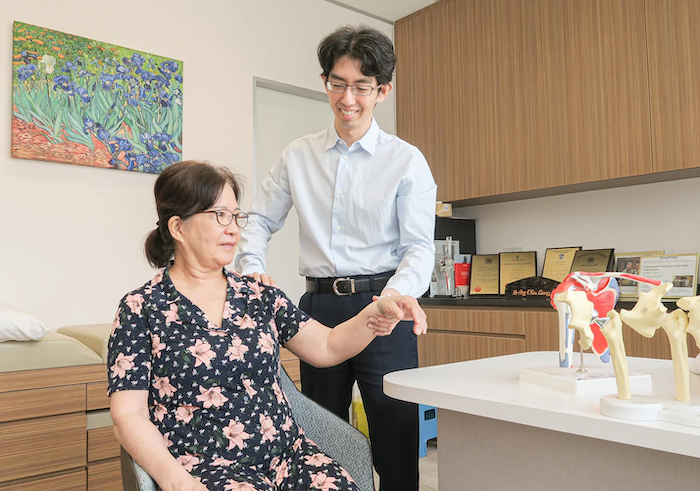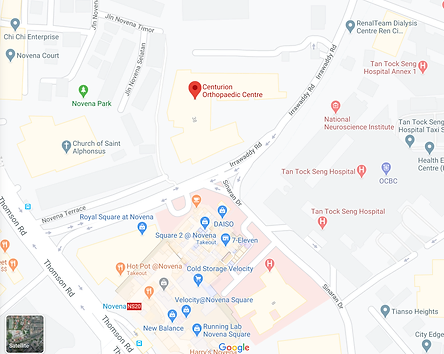Rotator Cuff

What is the Rotator Cuff?
Simple activities like combing your hair or reaching behind your back can be impossible when you have a rotator cuff issue such as a tear.
The rotator cuff is a group of muscles and tendons that surrounds and stabilises the shoulder joint. These tendons are important for moving your shoulder joint. A rotator cuff problem can cause either a dull or sharp ache in the shoulder, which worsens if you try to lift your arm up.
Causes of Rotator Cuff Tear
Rotator cuff injury may be the result of either a substantial injury to the shoulder or progressive degeneration of the tendon tissue. Repetitive overhead activity or heavy lifting over a prolonged period of time may irritate or damage the tendon.
A very common condition that develops in the 20s to 40s is Impingement. This refers to the tendon being rubbed by the overlying bone. Impingement causes episodic pain in certain positions, for example when putting on clothes or when sleeping on the shoulder.
Many people experience Impingement symptoms but do not realise its significance. When left untreated, it may lead to Rotator Cuff Tear. When a Rotater Cuff Tear is itself left for some time, the patient may develop Arthritis of the shoulder, which is wear-and-tear of the cartilage.
Symptoms & Risk Factors
Symptoms
The pain associated with a rotator cuff injury may:
Be described as a dull ache deep in the shoulder, or a sharp pain in certain positions
Disturb sleep
Make it difficult to comb your hair or reach behind your back
Be accompanied by arm weakness
Risk Factors:
Age. As you get older, your risk of a rotator cuff injury increases. Rotator cuff tears are most common in people older than 60.
Activity. Repetitive overhead activities such as lifting weights may be a risk factor for Rotater Cuff Injuries. Occupations such as carpentry or house painting require repetitive arm motions that may also be risk factors.
Family history. There may be a genetic component involved with rotator cuff injuries as they appear to occur more commonly in certain families.
Accurate diagnosis is one of the most important steps
in developing a customised & effective treatment plan.

Rotator Cuff Tear Diagnosis
See the doctor right away if you have immediate weakness in your arm after an injury.
During the physical examination, the doctor will press on different parts of your shoulder and move your arm into different positions. He will also test the strength of the muscles around your shoulder and in your arms.
In some cases, he may recommend imaging tests, such as:
X-rays. Although a rotator cuff tear won’t show up on an X-ray, this test can visualize bone spurs or other potential causes for your pain — such as arthritis.
Magnetic resonance imaging (MRI). This scan uses magnetic waves to obtain images of the internal parts of the shoulder in great detail.
Rotator Cuff Tear Treatment
Conservative treatments — such as rest, ice and physiotherapy — sometimes are all that is needed to recover from a rotator cuff injury. However, this is usually for milder cases.
Therapy
Physiotherapy is a basic treatment that involves exercises tailored to the specific location of your rotator cuff injury. In appropriate cases, therapy can help restore flexibility and strength to your shoulder. Physiotherapy is also an important part of the recovery process after rotator cuff surgery.
Injection
If conservative treatments haven’t reduced your pain, the doctor might recommend an injection into your shoulder joint, especially if the pain is interfering with your sleep, daily activities or physiotherapy.
Shoulder Scope Procedure
For more severe cases, a Key-Hole Tendon Repair procedure may be required. This procedure is performed using just small cuts on the skin and aims to reattach the torn tendon to the bone. In severe cases, this is the most effective way to remove pain, restore shoulder movement, and prevent progression to arthritis.
Frequently Asked Questions
Find quick answers to common queries, designed to help you navigate
your orthopaedic care journey with ease.
Surgery is a big thing. I am afraid...
To the patient, having to undergo a procedure is always frightening. Our team is here to help you through the process, we are with you at every step of the way.
Also, modern surgical methods are proven to be very safe with very low complication rates.
What advanced treatments do you have for my knee?
Advanced treatments include:
- Tissue-healing stimulant injections
- Arthroscopic (Key-Hole) procedures to repair cartilage and meniscus
- Shoulder Joint Replacements for advanced arthritis
Will my insurance cover the treatment?
There are many different medical plans with different coverage limits.
We are affiliated with many insurers and will help patients obtain approval for their treatment.
Do I need a referral letter from my family doctor?
You can come see us without having to obtain any referral letters first.
The exception is if you are using a corporate insurance plan, as some corporate insurers require you to see a family doctor on your panel first, and ask for a referral letter to us.
I injured my shoulder one month ago and it is still painful now. Should I get it checked?
Persistent pain usually means a significant problem. Simple strains and sprains rarely last more than 2 to 3 weeks.
The shoulder is a complex joint with many structures within it which can get injured.
If you have pain, and furthermore associated with a catching feeling, weakness, or sharp pains in certain angles, you should get it checked.
I have mild pain in the shoulder. Is it ok to continue with exercise or weights?
While level of pain is one indicator, it is not an accurate indicator.
For example, if the pain is due to a tissue tear, even though it is mild, you will need to reduce the activities.
The most important is first an accurate diagnosis.
What are the treatment methods for shoulder pain?
There are various treatment methods for joint pain, each with their own pros and cons. These will be discussed in detail by our specialist during consultation.
Generally, the methods include:
- medications
- supplements
- physiotherapy
- ergonomic and activity correction
- injections
- artificial gel
- Key-Hole procedure
- surgery

Centurion Orthopaedic Centre
38 Irrawaddy Road
Mt Elizabeth Novena Hospital Specialist Centre #07-40
Singapore 329563

Services
Medisave / Insurances
Treatments
Ankle Sprain & Treatment
Cartilage Repair Treatment
Bone Fracture Treatment
Alternatives to Knee Replacement
Knee Replacement Surgery
ACL Reconstruction Surgery
Knee Cartilage/Meniscus Tear Injury
Heel Spur Treatment
Hip Replacement Surgery
Hip Scope Surgery
Shoulder Scope Surgery
Ankle Ligament Surgery
Spinal Injection Therapy
Steroid Injection
Patient Resources